|
|
|
|
|
Oil On
Canvas, Real Flavor of Old Masters
|
|

|
ARTWORKS
INDEX
A B C D E F G H I J K L M N O P Q R S T U V W X Y Z |
ARTISTS
INDEX
A B C D E F G H I J K L M N O P Q R S T U V W X Y Z |
|
|
| | |
|
|
 |
c. a. dahlstrom -- Click Here
|
|
Carl Petter Dahlström, född ca 1705, död 4 mars 1794, var en svensk möbelsnickare. Dahlström gesällvandrade 1745?C1755 i Nordeuropa och Frankrike, där han i Paris kom i lära hos den tidens främste ebenist Jean-François Oeben. Hos denne lärde sig Dahlström faneringstekniken marqueterie ?? fleurs eller blomsterintarsia, som var en metod för att möta rokokons krav på fanering av dubbelvälvda kroppar. Mycket tack vare rekommendationer av C.J. Cronstedt blev Dahlström efter hemkomsten till Sverige utnämnd till kunglig ebenist den 19 november 1756. Han finns representerad på Nationalmuseum med en byrå som han tillverkade tillsammans med Lorentz Nordin. Dahlström överlämnade 1769 sina privilegier till Niclas Palmgren och ägnade sig därefter åt restaurangverksamhet. |
|
 |
BRUSASORZI, Domenico -- Click Here
|
|
Italian painter, Veronese school (b. 1516, Verona, d. 1567, Verona) |
|
 |
BRAY, Dirck -- Click Here
|
|
Dutch painter, Haarlem school (active 1651-1678) |
|
 |
BOUTS, Dieric the Younger -- Click Here
|
|
b. ca. 1448, Leuven, d. 1491, Leuven |
|
 |
BOUTS, Dieric the Elder -- Click Here
|
|
Flemish painter (b. ca. 1415, Haarlem, d. 1475, Leuven). |
|
 |
Bourel Aristide -- Click Here
|
|
Dunkerque 1840-Sartrouville 1924 |
|
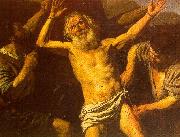 |
Boulogne, Valentin de -- Click Here
|
|
French Baroque Era Painter, ca.1594-1632 |
|
 |
Bonifacio de Pitati -- Click Here
|
|
painted Sacra Conversazione in 1515 |
|
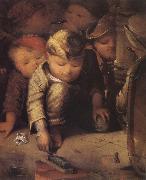 |
Blythe David Gilmour -- Click Here
|
|
American Painter, 1815-1865
He began his career as an itinerant portrait painter in the early 1840s and became one of the leading satirical artists in America by the beginning of the Civil War. Self-taught, from 1840 to 1850 he worked in East Liverpool, OH, and Uniontown, PA, and nearby towns and villages, painting rather stiff likenesses of the local gentry. He also carved a monumental polychrome wooden statue of Marie-Joseph, Marquis de Lafayette for the Uniontown courthouse and painted a landscape panorama of the Allegheny mountains, which he took on tour through Maryland, Pennsylvania and Ohio. |
|
 |
BICCI, Nero di -- Click Here
|
|
Italian Early Renaissance Painter, 1419-1491 |
|
 |
Bicci, Neri di -- Click Here
|
|
Italian Early Renaissance Painter, 1419-1491
was an Italian painter of the Renaissance. A prolific painter of mainly religious themes, he was active mainly in Florence and in the medium of tempera. His father was Bicci di Lorenzo (1373-1452). His grandfather, Lorenzo di Bicci (c. 1350-1427) was also a painter in Florence, a pupil of Spinello Aretino. He painted a St. Giovanni Gualberto enthroned, with ten Saints for the church of San Pancrazio. His journals from the years 1453-1475, |
|
 |
Bicci Di Neri -- Click Here
|
|
(1419-1491) was an Italian painter of the Renaissance. A prolific painter of mainly religious themes, he was active mainly in Florence and in the medium of tempera. His father was Bicci di Lorenzo. His grandfather, Lorenzo di Bicci was also a painter in Florence, a pupil of Spinello Aretino.
Neri di Bicci's main works include a St. John Gualbert Enthroned, with Ten Saints for the church of Santa Trinita, an Annunciation (1464) in the Florentine Academy, two altarpieces in the Diocesan Museum of San Miniato, a Madonna with Child Enthroned in the Pinacoteca Nazionale of Siena, and a Coronation of the Virgin (1472) in the abbey church at San Pietro a Ruoti (Bucine. He also painter numerous works in the area of Volterra.
His journals from the years 1453-1475, including the rates of remuneration for his work, are still preserved in the library of the Uffizi Gallery. They are known as Ricordanze.
|
|
 |
Bicci di Lorenzo -- Click Here
|
|
Italian, 1373-1452,was an Italian painter and sculptor, active in Florence. He was born in Florence in 1373, the son of the painter, Lorenzo di Bicci, whose workshop he joined. He married in 1418, and in 1424 was registered in the Guild of Painters at Florence. His son, Neri di Bicci was also a painter and took over the family workshop. Bicci di Lorenzo died in Florence in 1452 and was buried in Santa Maria del Carmine. Following early work - largely frescoes - in collaboration with his father, he received a number of important commissions, including, according to Vasari, from the Medici for a cycle of frescoes of Illustrious Men for the Palazzo Medici. For the Opera del Duomo, he painted frescoes of the apostles. And he painted a Saints Cosmas and Damian and frescoes representing the dedication of the church itself for Sant'Egidio in the hospital of Santa Maria Nuova. His best paintings are now thought to be the Madonna in Trono now in the National Gallery at Parma, the Three stories of St Nicholas triptych in the cathedral of Fiesole, and a Nativity in the church of San Giovannino dei Cavalieri in Florence. |
|
 |
Bernardo Daddi -- Click Here
|
|
active in Florence 1320-1348
was an early Italian renaissance painter and apprentice of Giotto. He was also influenced by the Sienese art of Lorenzetti. Daddi's birth date remains unknown. He is first mentioned in 1312. He focused on religious motifs and altarpieces. A triptych he painted in 1328 is in the Uffizi, and there are several panels in National Gallery of Art and the Walters Art Gallery. Daddi became the leading painter of Florence during his generation. His last work dates from 1347, |
|
 |
Bernaert de Ryckere -- Click Here
|
|
Bernaert de Rijckere (c1535, Kortrijk - 1590, Antwerp), was a Flemish Renaissance painter.
According to Karel van Mander he was born in Kortrijk and was admired there for an altarpiece depicting Christ bearing the cross, which he made for the St. Marten's church of the brothers of the Cross there. He later took on a different style that Karel van Mander had heard of but had not seen to be able to judge it for himself. He said he moved to Antwerp and joined the Guild of St. Luke there in 1561.
According to the Netherlands Institute for Art History he was the teacher of his son, the painter Abraham de Rijcke, and is known for landscapes and historical allegories. |
|
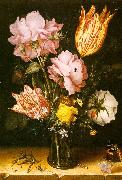 |
Berghe, Christoffel van den -- Click Here
|
|
Dutch, approx. 1590-1645 |
|
 |
Benjamin Duterrau -- Click Here
|
|
1767 - 1851 , was an artist in England and in early colonial Australia. Duterrau was was born in London to parents of French descent. Duterrau was apprenticed to an engraver and in 1790 did two coloured stipple engravings after Morland, The Farmer's Door and The Squire's Door. Taking up painting, between 1817 and 1823 he exhibited six portraits at Royal Academy exhibitions, and he also exhibited three genre pieces at the British Institution about the same period. Duterrau emigrated to Van Diemen's Land (now Tasmania), arriving in August 1832 with his daughter. He lived at the corner of Campbell and Patrick Streets in Hobart, and practised as a portrait painter. In 1835 he did some etchings of Indigenous Australians, the first examples of that craft to be done in Australia. His most famous painting The Conciliation is in the Hobart gallery with a self-portrait and other works, including some modelling in relief. A large landscape is in the Beattie collection at Launceston, and he is also represented in the Dixson collection at Sydney. Duterrau died at Hobart in 1851. |
|
 |
BECCAFUMI, Domenico -- Click Here
|
|
Italian Mannerist Painter, ca.1486-1551
Domenico was born in Montaperti, near Siena, the son of Giacomo di Pace, a peasant who worked on the estate of Lorenzo Beccafumi. Seeing his talent for drawing, Lorenzo adopted him, and commended him to learn painting from Mechero, a lesser Sienese artist.[1] In 1509 he traveled to Rome, but soon returned to Siena, and while the Roman forays of two Sienese artists of roughly his generation (Il Sodoma and Peruzzi) had imbued them with elements of the Umbrian-Florentine Classical style, Beccafumi's style remains, in striking ways, provincial. In Siena, he painted religious pieces for churches and of mythological decorations for private patrons, only mildly influenced by the gestured Mannerist trends dominating the neighboring Florentine school. There are medieval eccentricities, sometimes phantasmagoric, superfluous emotional detail and a misty non-linear, often jagged quality to his drawings, with primal tonality to his coloration that separates him from the classic Roman masters. |
|
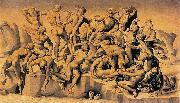 |
Bastiano da Sangallo -- Click Here
|
|
(1481 - May 31, 1551) was an Italian sculptor and painter of the Renaissance period, active mainly in Tuscany. He was a nephew of Giuliano da Sangallo and Antonio da Sangallo the Elder. He is usually known as Aristotile, a nickname he received from his air of sententious gravity. He was at first a pupil of Perugino, but afterwards became a follower of Michelangelo. Mentioned by Vasari as one who made a small copy of the Cartoon of Michelangelo Battle of Cascina (1506).
|
|
 |
BARTOLOMEO DI GIOVANNI -- Click Here
|
|
Italian Early Renaissance Painter, active 1475-1511
Bartolomeo di Giovanni, also known as Bartolommeo di Giovanni and as Alunno di Domenico, was an early renaissance Italian painter of the Florentine School who was active from about 1480 until his death in 1501. He studied with and assisted Domenico Ghirlandaio, painting the predella of Ghirlandaio's Adoration of the Magi in the Ospedale degli Innocenti (Foundling Hospital) in Florence, in 1488. Bartolomeo di Giovanni also worked under the guidance of Sandro Botticelli. |
|
 |
bartolomeo della gatta -- Click Here
|
|
(1448 -1502), born Pietro di Antonio Dei, was an Italian (Florentine) painter, illuminator, and architect. He was the son of a goldsmith. He was a colleague of Fra Bartolommeo. In 1468, Bartolomeo became a monk in the Order of Camaldoli, probably in the Church of Santa Maria degli Angeli in Florence, which his brother Nicolo had already entered. Upon taking holy orders, he changed his name to Bartolomeo. About 1481, he was summoned to Rome where he contributed to the cycle of frescos on the walls of the Sistine Chapel. Bartolomeo eventually became Abbot of San Clemente in Arezzo. He died in 1502 and was buried in the Abbey of San Clemente.
|
|
 |
Bartolo di Fredi -- Click Here
|
|
Italian Gothic Era Painter, ca.1330-1410
He had a large studio and was one of the most influential painters working in Siena and the surrounding towns in the second half of the fourteenth century. He registered in the Guild of that city in 1355; he had several children, who all died before him, with the exception of Andrea Bartoli. He was the companion of Andrea Vanni from 1353, and helped decorate the Hall of Council at Siena, in 1361. In 1362 he went to San Gimignano, where, by 1356, he had painted the entire side of the left aisle of the Pieve with scenes drawn from the Old Testament. In 1366 the Council of the city of Gimignano ordered a painting, representing Two Monks of the Augustine Order to be placed in the Palazzo Pubblico, in order to commemorate the settlement of some disputes which had long existed between that order and the city. In the early part of 1367 he returned to Siena, and was employed with Giacomo di Mino in the decorations of the cathedral. In 1372 he rose to a position in the government of the city, and was sent to welcome the new Podesta, on his approach to Siena. In 1381 he was himself made a member of the Council, and in 1382 he executed the Descent from the Cross now in the Sacristy of San Francesco, Montalcino. The same church also possesses panels painted by him containing the Baptism of Christ figures of SS. Peter, Paul, and Francis, and five scenes from the life of St. Philip of Montalcino. In 1389, Bartolo, assisted by Luca Thome, painted the altar-piece for the Shoemakers Company, in the Cathedral, and continued from that year until his death to furnish altar-pieces for the cathedral and other churches of Siena, which have now all disappeared.
His style is marked by the rejection of the concrete figures associated with Pietro Lorenzetti to instead favor flatter decorative otherworldly compositions in the manner of Simone Martini and Duccio. He combined a spirit of fantasy with anecdotal details.
The Honolulu Academy of Arts, the Los Angeles County Museum of Art, the Louvre, the Metropolitan Museum of Art, the Mus??e des Beaux-Arts (Chambery, France), the Musee du Petit Palais (Avignon, France), Museo Civico e Diocesano d Arte Sacra (Montalcinothe, Italy), the Museum of Fine Arts, Boston and the University of Virginia Art Museum are among the public collections having paintings by Bartolo di Fredi. |
|
 |
Bartholomeus van der Helst -- Click Here
|
|
1613-1670
Dutch
Bartholomeus Van Der Helst Galleries
Dutch painter. He was the son of a Haarlem inn-keeper and presumably undertook part or all of his training in Amsterdam. His earliest works suggest that the painter Nicolaes Eliasz. Pickenoy was his master. Although van der Helst had probably already established himself as an independent master by the time he married Anna du Pire in Amsterdam in 1636, his earliest known work, a portrait of The Regents of the Walloon Orphanage, Amsterdam (Amsterdam, Maison Descartes), dates from 1637. Stylistically it is close to the work of Pickenoy. His portrait of a Protestant Minister of 1638 (Rotterdam, Boymans-van Beuningen) reveals the influence of Rembrandt. The young artist must have risen rapidly to fame in Amsterdam, for as early as 1639 he received the prestigious commission for a large painting for the Kloveniersdoelen (Arquebusiers or Musketeers Hall): The Civic Guard Company of Capt. Roelof Bicker and Lt Jan Michielsz. Blaeuw (Amsterdam, Rijksmus.), which formed part of the same series as Rembrandt Night Watch (Amsterdam, Rijksmus.). Van der Helst may not have completed this commission until 1642 or 1643. The ingenious arrangement of the figures in a broad composition shows the artist special talent for composing large groups. Pickenoy influence is less noticeable here than in the portrait of 1637; the self-assured poses of the individual figures were to become a characteristic feature of van der Helst work. The successful execution of this portrait established van der Helst reputation: from 1642, when he began to receive an increasing number of commissions for individual portraits, until 1670 he was the leading portrait painter of the ruling class in Amsterdam. From 1642 his technique in portrait painting gradually became more fluent and the rendering of costume materials more detailed. Some typical portraits of his earlier period are those of Andries Bicker (Amsterdam, Rijksmus.), his wife Catharina Gansneb Tengnagel (Dresden, Gemeldegal. Alte Meister) and their son Gerard Bicker (Amsterdam, Rijksmus.), all of 1642, and the Portrait of a Young Girl (1645; London, N.G.). In 1648 van der Helst painted a second civic guard portrait, The Celebration of the Peace of M?nster at the Crossbowmen Headquarters, Amsterdam (Amsterdam, Rijksmus.), a superbly composed and well painted portrait that, until the late 19th century, was considered one of the masterpieces of the Golden Age but later lost popularity because of its smooth and modish execution. It can nevertheless still be regarded as one of the most important group portraits of the 17th century. Its technical perfection, characterized by a well-modelled rendering of the figures and a smooth handling of the brush, dominated the rest of van der Helst oeuvre. |
|
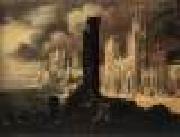 |
BARRA, Didier -- Click Here
|
|
French painter (b. 1590, Metz, d. 1644, Napoli
French painter, active in Italy. He was for a long time confused with FRAN?OIS DE NOM?, and the work of both artists was thought to be by a Mons? Desiderio, a 'highly praised painter of perspectives and city scenes' (de Dominici). It is now generally accepted that Mons? Desiderio was the pseudonym of Didier Barra (1982 exh. cat.), son of Cl?ment Barra. Didier Barra left Metz probably c. 1608, when his name appeared for the last time in the city archives. From c. 1630 he was active in Naples, where he came into contact with landscape and townscape painters from northern Europe. De Dominici wrote that he was associated with Belisario Corenzio. The point of departure in reconstructing Barra's oeuvre is the Panoramic View of Naples (Naples, Mus. N. S Martino), which is signed and dated Desiderius Barra ex civitate Methensi in Lotharingia, F. 1647. The picture is a precise and panoramic view of Naples from the sea, from a single viewpoint, enriched by lively brushwork and with spirited scenes of shipping in the foreground. Its topographical precision suggests that Barra was influenced by the engravings of large views of Naples made by Alessandro Baratta ( fl 1629-30), and he may himself have trained as a cartographer. On the basis of this picture, several views of Naples have been attributed to Barra. |
|
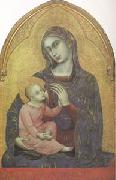 |
Barnaba Da Modena -- Click Here
|
|
active in Genoa and Pisa 1361-1383
was an Italian painter of the mid-14th century Lombardy. There is a painting by him in the church of San Francesco in Alba. A Virgin and Child once in Frankfort, was painted in a Byzantine style and is currently located at the Museum of Fine Arts in Boston, |
|
 |
Barna da Siena -- Click Here
|
|
Italian Painter, active ca.1350
Barna da Siena, also known as Barna di Siena, was a Sienese painter active from about 1330 to 1350, and was the painter in Siena during this period. He learned his trade from Simone Martini. Barna is believed to have paint the frescoes depicting the life of Jesus in the Collegiata di San Gimignano and is generally credited with Christ Bearing the Cross, with a Dominican Friar in the Frick Collection in New York City. He was killed in a fall from the scaffolding. Barna's figures are more dramatic and vigorous than any in previous Sienese painting. |
|
 |
BARBARI, Jacopo de -- Click Here
|
|
Italian Early Renaissance Painter, ca.1440-1515
Italian painter and printmaker. He was the first Italian Renaissance artist of note who travelled to the courts of Germany and the Netherlands. His earliest known works appear to date from the late 1490s, suggesting that he was born c. 1460-70. The birthdate of c. 1440 traditionally assigned to him reflects the misinterpretation of a document of 1512 in which his patron, Margaret of Austria, Regent of the Netherlands, awarded him a stipend because of his 'weakness and old age'. In fact, at this date a man could be described as 'old' while in his fifties or even younger. |
|
 |
Balthasar van der Ast -- Click Here
|
|
(1593/94 - 1657) was a Dutch Golden Age painter who specialized in still lifes of flowers and fruit, as well as painting a number of remarkable shell still lifes; he is considered to be a pioneer in the genre of shell painting. His still lifes often contain insects and lizards. He was born in Middelburg and died at Delft.
|
|
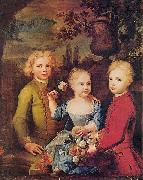 |
Balthasar Denner -- Click Here
|
|
(15 November 1685 in Altona - 14 April 1749 in Rostock) was a German painter, highly-regarded as a portraitist. He painted mostly half-length and head-and-shoulders portraits and a few group portraits of families in interiors. Usually Denner concentrated on the face; clothes and paraphernalia were done by other painters or later his daughter. |
|
 |
Balthasar Anton Dunker -- Click Here
|
|
German, 1746-1807 |
|
 |
BACKER, Jacob de -- Click Here
|
|
Flemish painter (b. 1555/60, Antwerpen, d. 1585/90, Antwerpen)
Flemish painter and draughtsman. According to van Mander, as a young boy de Backer was abandoned by his father, also a painter, who had to flee Antwerp because of an impending court trial. Jacob then worked for several years in the studio of Antonio van Palermo (1503/13-before 1589) and later entered the workshop of Hendrick van Steenwijck. Van Mander further claimed that the strenuous labour that van Palermo had imposed on the young man had so wrecked his health that he died at the age of 30, in the arms of his former master's daughter. This, van Mander added, happened a long time ago, thus implying that de Backer died before van Steenwijck left Antwerp in 1586. This is confirmed by other evidence, including the age of van Palermo's daughter Lucretia, who was baptized in Antwerp on 25 July 1561. She lived until 1626 and at the time of her death still possessed six paintings by de Backer. |
|
 |
BABUREN, Dirck van -- Click Here
|
|
Dutch Baroque Era Painter, 1595-1624
1624). Dutch painter. His father, Jasper van Baburen (d ?1599), had been in the service of Geertruijd van Bronckhorst van Battenburg, Baroness (vrijvrouw) of Vianen, Viscountess (burggravin) of Utrecht, and thus Dirck must have received a better than average education, a fact at least partially confirmed by the innovative and often literary nature of his subject-matter. In 1611 he is recorded as a pupil of the portrait and history painter Paulus Moreelse in Utrecht. It is likely that this was the last year of his apprenticeship. Van Baburen probably left for Italy shortly after 1611, for a document rediscovered in the late 1980s records a signed and dated altarpiece of the Martyrdom of St Sebastian (1615; untraced), executed for a church in Parma. His most important pictures made in Italy were painted in collaboration with David de Haen (d 1622) for the Piet? Chapel of S Pietro in Montorio, Rome, which was decorated between 1615 and 1620. Van Baburen's paintings for the chapel were mentioned by Giulio Mancini in his manuscript notes, Considerazioni sulla pittura (c. 1619-20); there Mancini claims the artist was 22 or 23 years old when he carried out the commission. One of his best-known works, the Entombment (formerly dated 1617), is still in situ on the altar of the chapel. This much-copied composition reveals van Baburen's close study of Caravaggio's famous Entombment (Rome, Pin. Vaticana). In 1619 and the spring of 1620 van Baburen and de Haen were recorded as living in the same house in the Roman parish of S Andrea delle Fratte. Caravaggio's close follower and presumed student, Bartolomeo Manfredi, was living in the same parish in 1619. Van Baburen must have known the works of Manfredi. |
|
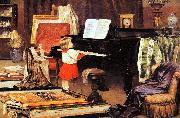 |
Aurelio de Figueiredo -- Click Here
|
|
painted Girl at the piano in 1892 |
|
 |
Aureliano De Beruete Y Moret -- Click Here
|
|
Spanish , Madrid, 1845 - Madrid, 1912
Spanish writer, painter and collector. After pursuing a political career and taking a doctorate in civil and canon law, he dedicated himself to writing on art and produced important studies on Diego Velezquez (1898), Joaqu'n Sorolla y Bastida (1901) and other artists. He travelled extensively and enthusiastically in Europe (France, Belgium, Switzerland, the Netherlands, Italy, Germany, England and elsewhere), studying especially the different national schools of painting. On his travels he also painted landscapes. After working for some time as a copyist in the Museo del Prado, Beruete decided in 1873 to concentrate his efforts on painting and on learning to perfect his craft. He enrolled at the Escuela Superior de Bellas Artes de S Fernando in Madrid and also studied at the studio of Carlos de Haes. Beruete was among the founders of the Instituci'n Libre de Enseeanza, and with its members, and with Carlos de Haes, he made several study trips abroad. In Paris he came to know the painting of the Barbizon school, and in Belgium he assimilated the teaching of the generation of landscape artists who had adopted a form of Realism. |
|
|
|
|
|
 |
Attributed to John de Critz the Elder -- Click Here
|
|
painted Portrait of Anne of Denmark in c. 1605 |
|
 |
Attributed to Jan de Beer -- Click Here
|
|
painted Madonna and Child with a pilgrim and an angel in c. 1490-1515
|
|
 |
ATTAVANTE DEGLI ATTAVANTI -- Click Here
|
|
Italian miniaturist, Florentine school (b. 1452, Castelfiorentino, d. ca. 1525, Firenze) |
|
 |
AST, Balthasar van der -- Click Here
|
|
Dutch Baroque Era Painter, ca.1593-1656
1657). Dutch painter. He was the brother-in-law of Ambrosius Bosschaert (i), whose household he entered in 1609, after the death of his father. He remained as Bosschaert's pupil, until he was 21. In 1615 van der Ast moved with the Bosschaert family to Bergen-op-Zoom. However, a year later the Bosschaerts were living in Utrecht, but van der Ast is not recorded there until 1619, when he was entered as a master in the Guild of St Luke. He remained in Utrecht until 1632, then lived in Delft, where he enrolled in the painters' guild on 22 June 1632. On 26 February 1633 he married Margrieta Jans van Bueren in Delft, where he spent the rest of his career; the marriage produced two children. |
|
 |
Asher Brown Durand -- Click Here
|
|
1796-1886
Asher Brown Durand Galleries
His interest shifted from engraving to oil painting around 1830 with the encouragement of his patron, Luman Reed. In 1837, he accompanied his friend Thomas Cole on a sketching expedition to Schroon Lake in the Adirondacks and soon after he began to concentrate on landscape painting. He spent summers sketching in the Catskills, Adirondacks, and the White Mountains of New Hampshire, making hundreds of drawings and oil sketches that were later incorporated into finished academy pieces which helped to define the Hudson River School.
Durand is particularly remembered for his detailed portrayals of trees, rocks, and foliage. He was an advocate for drawing directly from nature with as much realism as possible. Durand wrote, "Let [the artist] scrupulously accept whatever [nature] presents him until he shall, in a degree, have become intimate with her infinity...never let him profane her sacredness by a willful departure from truth."
Like other Hudson River School artists, Durand also believed that nature was an ineffable manifestation of God. He expressed this sentiment and his general views on art in his "Letters on Landscape Painting" in The Crayon, a mid-19th century New York art periodical. Wrote Durand, "[T]he true province of Landscape Art is the representation of the work of God in the visible creation..."
Durand is noted for his 1849 painting Kindred Spirits which shows fellow Hudson River School artist Thomas Cole and poet William Cullen Bryant in a Catskills landscape. This was painted as a tribute to Cole upon his death in 1848. The painting, donated by Bryant's daughter Julia to the New York Public Library in 1904, was sold by the library through Sotheby's at an auction in May 2005 to Alice Walton for a purported $35 million. The sale was conducted as a sealed, first bid auction, so the actual sales price is not known. At $35 million, however, it would be a record price paid for an American painting at the time. |
|
 |
ASAM, Cosmas Damian -- Click Here
|
|
German Baroque Era Sculptor, 1686-1739
Bavarian architects and decorators. After studying in Rome (1711 ?C 13), Cosmas Damian became a prolific fresco painter, and his brother, Egid Quirin, became a sculptor and stuccoist. They developed the effects of dramatic lighting and illusionism originated by Gian Lorenzo Bernini and Andrea Pozzo. Working as a team, they produced magnificent illusionistic decoration in ecclesiastical buildings, combining dramatic lighting and colour. Their works are notable for their profound and dramatic intensity of religious feeling. The brothers became the principal late Baroque exponents of illusionist decoration in religious architecture. Their most notable collaboration is the church of St. John Nepomuk in Munich (1733 ?C 46) ?? known as the Asamkirche in honour of the brothers. |
|
 |
Ary de Vois -- Click Here
|
|
was a Dutch Golden Age painter.
Ary de Vois was the son of Alewijn de Vois from Utrecht, who was organist in the Pieterskerk, Leiden, in 1635. Ary became a pupil in Utrecht of Nikolaus Knepfer, who also taught Jan Steen. Ary then returned to Leiden to study with Abraham van den Tempel, who lived there between 1648 and 1660. De Vois joined the Leiden Guild of St Luke on 16 October 1653, paying dues until 1677. He was dean in 1662-64, headman in 1664-65 and dean again from 1667-68. He married Maria van der Vecht, on 5 February 1656.
According to Houbraken his marriage caused a lull in his production, especially when he moved to Warmond where he took up fishing as a hobby. He had to move back to Leiden in order to keep his production levels high
|
|
 |
Artur Timoteo da Costa -- Click Here
|
|
Brazilian
1882-1923
Artur Timoteo da Costa Gallery
|
|
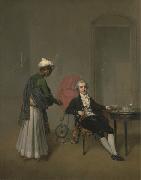 |
Arthur William Devis -- Click Here
|
|
(10 August 1762 - 11 February 1822) was an English painter of history paintings and portraits. He was appointed draughtsman in a voyage projected by the East India Company in 1783, under Captain Henry Wilson, in which he was wrecked on the Pelew Islands before proceeding to Canton and thence to Bengal. He painted portraits and historical subjects, sixty-five of which he exhibited (1779-1821) at the Royal Academy.
|
|
 |
Arthur Devis -- Click Here
|
|
1712-1787
English
By 1728 he had left Preston, and the following year he was working in London for the Flemish topographical and sporting painter Peter Tillemans. There he specialized in landscape painting and copying various works in Tillemans studio after Marco Ricci, Giovanni Paolo Panini and Jan van Bloemen. Devis earliest known commission, Hoghton Towers from Duxon Hill, Lancashire (1735; priv. col., see 1983 exh. cat., no. 3), painted for Sir Henry Hoghton during a trip to Preston in 1734-5, shows Tillemans influence in its attention to detail and the use of thin, transparent paint. Thomas Lister with his Family (c. 1738; Chicago, IL, A. Inst.) demonstrates a similar interest in landscape, featuring the family group in Gisburn Park, Lancs. Devis had returned to London by 1742 and established himself as a painter of conversation pieces, with a studio in Great Queen Street. Roger Hesketh with his Family is typical of his work at this time; it shows how Devis transformed the intimacy of a Dutch 17th-century genre scene into an elegant interior with the group of sitters connected by formal, schematic gestures. Roger Hesketh stands apart, in a tastefully contrived pose, his legs crossed and right arm thrust inside his waistcoat. His son, Fleetwood, stands with his hand resting on a dog next to his wife, who is seated with an infant on her lap. The adjacent telescope, globe and marine paintings are intended to advertise Hesketh interest in astronomy and travel. |
|
 |
Arthur Bowen Davies -- Click Here
|
|
1862-1928
Arthur Bowen Davies Gallery
Arthur Bowen Davies (September 26, 1863 ?C October 24, 1928) was an avant-garde American artist.
He was born in Utica, New York and studied at the Chicago Academy of Design from 1879 to 1882. He briefly attended the Art Institute of Chicago and then moved to New York City where he studied at the Art Students League.
Davies was a principal organizer of the 1913 Armory Show and was a member of The Eight, a group of painters including five associated with the Ashcan school: William Glackens (1870-1938), Robert Henri (1865-1929), George Luks (1867-1933), Everett Shinn (1876-1953) and John French Sloan (1871-1951), along with Arthur B. Davies (1862-1928), Ernest Lawson (1873-1939) and Maurice Prendergast (1859-1924). Davies is best known for his ethereal figure paintings. He worked as a billboard painter, engineering draftsman, and magazine illustrator. |
|
 |
Armando de Basto -- Click Here
|
|
painted Retrato in 1910 |
|
 |
Armand-Vincent de Montpetit -- Click Here
|
|
painted Louis XV King of France and Navarre in 1774 |
|
 |
Arent De Gelder -- Click Here
|
|
1645-1727
was one of Rembrandt's last pupils while in Amsterdam, studying in his studio from 1661 to 1663. He was not only one of the most talented of Rembrandt's pupils, but also one of his most devoted followers, for he was the only Dutch artist to paint in the tradition of Rembrandt's late style into the 18th century. |
|
 |
Arellano, Juan de -- Click Here
|
|
Spanish Baroque Era Painter, 1614-1676
Spanish painter. He was the pre-eminent painter of flower-pieces in 17th-century Spain. Although Spaniards of the previous generation had painted such works, it was the inspiration of Flemish and Italian examples in Madrid that from c. 1650 encouraged Arellano's success as a specialist in this genre. According to Palomino, who moved to the Court shortly after the artist's death and befriended many painters who had known him, Arellano began to paint flowers only in his thirties after a beginning that showed little promise. |
|
|
|
Apollonio di Giovanni -- Click Here
|
|
ca.1415-1465
Italian painter and illuminator. He was trained by illuminators in the circle of Bartolomeo di Fruosino and Battista di Biagio Sanguini (1393?C1451) and became a member of the Arte dei Medici e degli Speziali in 1442 and of the Compania di S Luca in 1443. Apollonio was influenced by Filippo Lippi, Lorenzo Ghiberti and Paolo Uccello. |
|
 |
Antonio Munoz Degrain -- Click Here
|
|
Spanish , Valencia, 1840 - M - laga, 1924 |
|
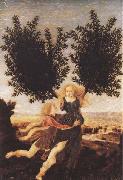 |
Antonio del Pollaiuolo -- Click Here
|
|
b.
1431/32, Firenze, d. 1498, Roma |
|
 |
Antonio de Puga -- Click Here
|
|
painted San Jeronimo in 1636 |
|
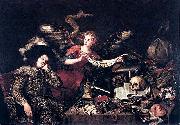 |
Antonio de Pereda -- Click Here
|
|
(ca. 1611-1678) was a Spanish Baroque-era painter , best known for his still lifes. Pereda was born in Valladolid. He was the eldest of three brothers from an artistic family. His father, mother and two brothers were all painters. He was educated in Madrid by Pedro de las Cuevas and was taken under the protective wing of the influential Giovanni Battista Crescenzi.After Crescenzi's death in 1635, Pereda was expelled from the court and began to take commissions from religious institutions. As well as still lifes and religious paintings, Pereda was known for his historical paintings such as the Relief of Genoa (1635) which was painted for the Buen Retiro Palace in Madrid as part of the same series as Velezquez's Surrender of Breda.
|
|
 |
Antonio da Firenze -- Click Here
|
|
Italian Early Renaissance Painter, ca.1445-1510 |
|
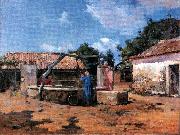 |
Antonio Carvalho de Silva Porto -- Click Here
|
|
(Porto, 11 November 1850 - Porto, 11 June 1893) was a Portuguese naturalist painter.
Born in Porto, he studied there under João Antenio Correia and T. Furtado, then continued his studies in Paris and Rome.
While in Paris he exhibited his work in the Salon and in the World´s Fair of 1878. In Paris, he studied with his friend João Marques de Oliveira, where they were pupils of Adolphe Yvon and Alexandre Cabanel. They became followers of the naturalist Barbizon School, and brought the new school of painting to Portugal, when they returned in 1879.
Silva Porto become one of the most acclaimed naturalist painters of his generation, showing the heritage of Jean-Baptiste Camille Corot and Charles-François Daubigny. Secondary effects from impressionism can sometimes be found in his paintings.
|
|
 |
antonin dvorak -- Click Here
|
|
Named after Prince Antoni Radziwiłł, who built a wooden summer residence here between 1822 and 1824 for his family. The Radziwiłł family played an important role in Polish?CLithuanian history over several centuries and owned lands larger than the state of Belgium. |
|
 |
Antonello da Messina -- Click Here
|
|
1430-1479
Italian
Antonello da Messina Galleries
Antonello was born at Messina around 1429-1431, to Giovanni de Antonio Mazonus and Garita (Margherita). He was probably apprenticed in his native city and in Palermo.
Around the year 1450, according to a 1524 letter of the Neapolitan humanist Pietro Summonte,[1] he was a pupil of the painter Niccol?? Colantonio at Naples, then one of the most active centres of Renaissance arts.
Around 1455 he painted the so-called Sibiu Crucifixion, which was inspired by the Flemish Calvaries and is housed in the Muzeul de Art?? in Bucharest. Of the same years is the Crucifixion in the Royal Museum of Antwerp: his early works shows a marked Flemish influence, which it is now understood he derived from his master Colantonio and from works by Rogier van der Weyden and Jan van Eyck that belonged to Colantonio's patron, Alfonso V of Aragon; his biographer Vasari remarked that Antonello saw at Naples an oil painting by Jan Van Eyck (the "Lomellini Tryptych") belonging to King Alphonso of Aragon; Vasari's further narrative, that being struck by the new method, set out for The Netherlands to acquire a knowledge of the process from Van Eyck's disciples is discredited today. Another theory, supported only by vague documentary evidence, suggests that in 1456 Antonello visited Milan, where he might have met Van Eyck's most accomplished follower, Petrus Christus. Since Antonello was one of the first Italians to master Eyckian oil painting, and Christus was the first Netherlandish painter to learn Italian linear perspective, their meeting is a tempting answer to both questions. But in fact, neither artist is known for certain to have been in Milan at the time.
The following year, Antonello received his first commission as an independent artist, a banner for the Confraternit?? di San Michele dei Gerbini in Reggio Calabria. At this date, he was already married, and his son Jacobello had been born.
In 1460, his father is mentioned leasing a brigantine to bring back Antonello and his family from Amaltea, a town in Calabria. In that year, Antonello painted the so-called Salting Madonna, in which standard iconography and Flemish style are backed by a greater attention in the volumetric proportions of the figures, probably coming from his knowledge of some works by Piero della Francesca. Also from around 1460 are the two small panels depicting Abraham Served by the Angels and St. Jerome Penitent now in the Museo Nazionale della Magna Grecia in Reggio Calabria. In 1461 his younger brother Giordano entered Antonello's workshop, signing a three-years' contract. Of that year is a Madonna with Child for the Messinese nobleman Giovanni Mirulla, now lost.
Between 1465-1470, Antonello finished a Portrait of a Man now at Cefal??. His portraits are noteworthy for his characteristic use of the three-quarter view, typical of the Flemish School, whereas almost all Italian painters adopted the medal profile pose. Antonello travelled to Venice around 1470, to see Giovanni Bellini's paintings.
The Palermo Annunciation.In this year he executed his first signed and dated work, the Salvator Mundi. Back at Sicily, Antonello finished the St. Gregory's Polyptych.
In 1474, he painted the Annunciation, now in Syracuse, and the St. Jerome in His Study, one of his most famous paintings. The following year he began his regular sojourn in Venice, where he remained until the fall of 1476. His works of this period begin to show a greater attention to the human figure, regarding both anatomy and expressivity, according to the influence of Piero della Francesca and Bellini.
His most famous pictures dating from this period include the Condottiero (Louvre, illustration), the San Cassiano Altarpiece and the St. Sebastian (see selected works for details). The San Cassiano Altarpiece was especially influential on Venetian painters, as it was one of the first of the large compositions in the sacra conversazione format which was perfected by Giovanni Bellini (Antonello's surviving work in Vienna is only a fragment of the much larger original).
Antonello returned briefly to Sicily in 1476, where he painted the famous Virgin Annunciate, now in the Palazzo Abatellis at Palermo.
He died at Messina in 1479: his testament dates from February of that year, and he is documented as no longer alive two months later. Some of his last works remained unfinished, but were completed by his son Jacobello. |
|
|
|
 |
Anton Domenico Gabbiani -- Click Here
|
|
1652-1726
Italian
Anton Domenico Gabbiani Gallery
Italian painter. He first trained with the Medici court portrait painter Giusto Suttermans and then with the painter Vincenzo Dandini. On 20 May 1673 he arrived in Rome, where he studied for three years under Ciro Ferri and Ercole Ferrata at the Accademia Fiorentina. He responded in particular to the paintings of Pietro da Cortona and Carlo Maratti who were both to be important influences on him. Though not precocious, Gabbiani became one of the most noted painters from the Accademia. After a period in Venice (1678-9) with the portrait painter Sebastiano Bombelli, he was in Florence in 1680. By 1684, the year in which he executed an Annunciation (destr.) for the Palazzo Pitti, he was an independent painter. His first important public commission, the St Francis de Sales in Glory (1685) for the church of SS Apostoli, Florence (in situ), shows the influence of Maratti in its grandiose composition and that of Dandini in the treatment of figures. In Prince Ferdinando de Medici Gabbiani found a particularly loyal patron, and he painted his portrait, Ferdinando de Medici and his Musicians (c. 1685; Florence, Pitti). One of the works executed for Ferdinando was possibly a portrait of his sister, which Chiarini has identified with the painting of Anna Maria Luisa de Medici (c. 1685; Florence, Pitti). Further works from this period are the group portrait of Three Musicians (Florence, Pitti) at Ferdinando court and a Group of Courtiers (1685-90; Florence, Uffizi). |
|
 |
Anton Doll -- Click Here
|
|
painted Ansicht von Garmisch in 19th century
|
|
 |
Antoine de Favray -- Click Here
|
|
French, 1706-died circa 1791,French painter. He is not documented until 1738, when he was mentioned as a private pupil of Jean-Fran?ois de Troy (ii), who was then director of the Acad?mie de France in Rome; in 1739 he became an official student at the Acad?mie. Among his student works is a copy (untraced) of Raphael's Fire in the Borgo (Rome, Vatican, Stanza dell'Incendio), which was mentioned by Charles de Brosses and exhibited in Paris in 1741. In 1744, for reasons that are not clear, he left Rome for Malta, remaining there for much of the rest of his career and devoting himself primarily to portraiture and genre painting. His ambition as a history painter, however, was fulfilled to a certain extent as a result of the patronage of two Grand Masters of the Order of the Knights of Malta, Manoel Pinto da Fonseca and Emmanuel de Rohan. His first dated picture executed in Malta is a Portrait of a Maltese Lady (1745; Paris, Louvre). |
|
 |
Anthony Van Dyck -- Click Here
|
|
Dutch
1599-1641
Anthony Van Dyck Locations
Flemish painter and draughtsman, active also in Italy and England. He was the leading Flemish painter after Rubens in the first half of the 17th century and in the 18th century was often considered no less than his match. A number of van Dyck studies in oil of characterful heads were included in Rubens estate inventory in 1640, where they were distinguished neither in quality nor in purpose from those stocked by the older master. Although frustrated as a designer of tapestry and, with an almost solitary exception, as a deviser of palatial decoration, van Dyck succeeded brilliantly as an etcher. He was also skilled at organizing reproductive engravers in Antwerp to publish his works, in particular The Iconography (c. 1632-44), comprising scores of contemporary etched and engraved portraits, eventually numbering 100, by which election he revived the Renaissance tradition of promoting images of uomini illustri. His fame as a portrait painter in the cities of the southern Netherlands, as well as in London, Genoa, Rome and Palermo, has never been outshone; and from at least the early 18th century his full-length portraits were especially prized in Genoese, British and Flemish houses, where they were appreciated as much for their own sake as for the identities and families of the sitters. |
|
 |
anthonis van dyck -- Click Here
|
|
Flemish painter and draughtsman, active also in Italy and England. He was the leading Flemish painter after Rubens in the first half of the 17th century and in the 18th century was often considered no less than his match. A number of van Dyck's studies in oil of characterful heads were included in Rubens's estate inventory in 1640, where they were distinguished neither in quality nor in purpose from those stocked by the older master. Although frustrated as a designer of tapestry and, with an almost solitary exception, as a deviser of palatial decoration, van Dyck succeeded brilliantly as an etcher. He was also skilled at organizing reproductive engravers in Antwerp to publish his works, in particular The Iconography (c. 1632-44), comprising scores of contemporary etched and engraved portraits, eventually numbering 100, by which election he revived the Renaissance tradition of promoting images of uomini illustri. His fame as a portrait painter in the cities of the southern Netherlands, as well as in London, Genoa, Rome and Palermo, has never been outshone; and from at least the early 18th century his full-length portraits were especially prized in Genoese, British and Flemish houses, where they were appreciated as much for their own sake as for the identities and families of the sitters.
|
|
 |
Anthonis Van Dashorst Called antonio Moro -- Click Here
|
|
Utrecht 1519-Antwerp 1575 |
|
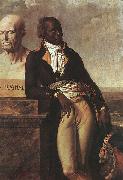 |
Anne-Louis Girodet de Roussy-Trioson -- Click Here
|
|
(also given as Anne-Louis Girodet de Roucy-Triosson, Anne-Louis Girodet-Trioson) January 5, 1767 - December 9, 1824), was a French painter and pupil of Jacques-Louis David, who was part of the beginning of the Romantic movement by adding elements of eroticism through his paintings. Girodet is remembered for his precise and clear style and for his paintings of members of the Napoleonic family.
|
|
 |
anna dorothea therbusch -- Click Here
|
|
1721-82
German painter of Polish descent. She was taught by her father, the portrait painter Georg Lisiewski (1674-1751), and received further training from Antoine Pesne in Paris. She worked for Charles-Eugene, Count of W?rttemberg, in Stuttgart from 1761 to 1762, and for Charles Theodore Wittelsbach, Elector Palatine of the Rhine, in Mannheim from 1763 to 1764. In 1765 she returned, via Stuttgart and Hohenzollern-Hechingen, to Paris, where in 1767 she became a member of the Academie Royale. She met Denis Diderot and Philipp Hackert, both of whom she painted, and Charles-Nicolas Cochin , but, despite consistent support from Prince Galitsyn, she was unable to establish herself in Paris. In 1769 she returned to Berlin where she received commissions for mythological paintings (e.g. Diana and her Nymphs, 1771; Potsdam, Neues Pal.) from Frederick II, King of Prussia. She painted portraits of members of the Prussian court, and the Berlin bourgeoisie, and in 1773 was commissioned by Catherine II, Empress of Russia, to paint a portrait of the Prussian royal family. |
|
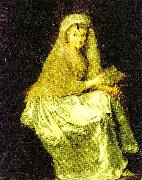 |
anna dorothea lisiewska therbusch -- Click Here
|
|
Lisiewski, Anna Dorothea (von) / Lisiewska-Therbusch, Anna Dorothea / Liszeswka, Anna Dorothea.
Anna Dorothea Therbusch (somtetimes Anna Dorothea Therbusch-Lisiewska, or Lisiervska/Lisziewska/Liesiewka (1721-1782) was a German painter.
|
|
 |
Andreas Edvard Disen -- Click Here
|
|
Norway (1845 -1923 ) - Painter
|
|
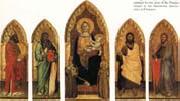 |
Andrea di Orcagna -- Click Here
|
|
Italian Byzantine Style Painter, ca.1320-1368 |
|
 |
Andrea Di Giusto -- Click Here
|
|
b Florence, c. 1400; d Florence, 2 Sept 1450
Italian painter. He was an eclectic minor Florentine master who was influenced by, and at different times imitated, the styles of Masaccio, Masolino, Lorenzo Monaco, Fra Angelico and Domenico Veneziano. In 1426 he was an assistant of Masaccio in the execution of the altarpiece for the Carmine church in Pisa (London N.G.; Naples, Capodimonte; Berlin, Gem?ldegal.; Malibu, CA, Getty Mus.; Pisa, Mus. N. & Civ. S Matteo) and painted its predella panels of the Legend of St Julian and the Charity of St Nicholas (Berlin, Gem?ldegal.). His name appears in the tax registers of the Florentine Archivio delle Decime from 1427 to 1447 and in the protocols of the Arte della Calimala in 1436, the same year in which he received 60 florins for an altarpiece (destr.) for S Lucia dei Magnoli. In 1437 he signed and dated the Assumption of the Virgin with SS Catherine and Francis (Florence, Accad.). His other dated works are a Virgin and Child with Four Saints (1435; Prato, Mus. Com.), which is a copy of Lorenzo Monaco's Monte Oliveto Altarpiece of 1410 (Florence, Pal. Davanzati); a Virgin and Child (1435; Florence, Villa I Tatti), a rustic interpretation of a Virgin and Child by Fra Angelico (Turin, Gal. Sabauda) |
|
 |
Andrea del Verrocchio -- Click Here
|
|
Italian Early Renaissance Sculptor, ca.1435-1488
Florentine sculptor and painter, whose real name was Andrea di Michele di Francesco di Cioni. He was a leading figure in the early Renaissance, and his workshop was a center for the training of young artists in Florence. A virtuoso metalworker, Verrocchio was primarily concerned with the spirited rendering of movement and the elaboration of detail. Many of his paintings are lost. Of the remaining panels, his hand is evident in the Baptism of Christ (Uffizi), assisted by Leonardo da Vinci. In the Pistoia altarpiece he was aided by Lorenzo di Credi. Other attributions are Tobias and the Angel (National Gall., London), two paintings of the Madonna and Child (National Gall., London; Berlin), and a Crucifixion with Saints (Argiano). Most of Verrocchio's achievements in sculpture have survived. His earlier work includes the bold group Incredulity of St. Thomas (Orsanmichele). In 1472 he designed the tombs of Piero and Giovanni de' Medici (San Lorenzo). In the same period he created the graceful Boy with a Dolphin and a lithe portrayal of David (Bargello). He went to Venice (c.1480) to work on the equestrian monument of the condottiere Bartolomeo Colleoni. |
|
 |
Andrea del Sarto -- Click Here
|
|
b.July 16, 1486, Florence
d.Sept. 28, 1530, Florence
Italian Andrea del Sarto Galleries
Andrea del Sarto (1486 ?C 1531) was an Italian painter from Florence, whose career flourished during the High Renaissance and early-Mannerism. Though highly regarded by his contemporaries as an artist "senza errori" (i.e., faultless), he is overshadowed now by equally talented contemporaries like Raphael.
Andrea fell in love with Lucrezia (del Fede), wife of a hatter named Carlo, of Recanati; the hatter dying opportunely, Andrea married her on 26 December 1512. She has come down to us in many a picture of her lover-husband, who constantly painted her as a Madonna and otherwise; even in painting other women he made them resemble Lucrezia. She was less gently handled by Giorgio Vasari, a pupil of Andrea, who describes her as faithless, jealous, and vixenish with the apprentices; her offstage character permeates Robert Browning's poem-monologue "Andrea del Sarto called the 'faultless painter'" (1855) .
He dwelt in Florence throughout the memorable siege of 1529, which was soon followed by an infectious pestilence. He caught the malady, struggled against it with little or no tending from his wife, who held aloof, and he died, no one knowing much about it at the moment, on 22 January 1531, at the comparatively early age of forty-three. He was buried unceremoniously in the church of the Servites. His wife survived her husband by forty years.
A number of paintings are considered to be self-portraits. One is in the National Gallery, London, an admirable half-figure, purchased in 1862. Another is at Alnwick Castle, a young man about twenty years, with his elbow on a table. Another youthful portrait is in the Uffizi Gallery, and the Pitti Palace contains more than one. |
|
 |
Andrea del Castagno -- Click Here
|
|
Italian
c1421-1457
Andrea del Castagno Location
Italian
c1421-1457
Andrea del Castagno Location
Italian painter. He was the most influential 15th-century Florentine master, after Masaccio, of the realistic rendering of the figure and the representation of the human body as a three-dimensional solid by means of contours. By translating into the terms of painting the statues of the Florentine sculptors Nanni di Banco and Donatello, Castagno set Florentine painting on a course dominated by line (the Florentine tradition of disegno), the effect of relief and the sculptural depiction of the figure that became its distinctive trait throughout the Italian Renaissance, a trend that culminated in the art of Michelangelo. |
|
 |
ANDREA DA MURANO -- Click Here
|
|
Italian painter, Venetian school (known 1462-1502)
Italian painter. He is first recorded working as a gilder at S Zaccaria, Venice, in 1463-5. He was one of a number of artists from the island of Murano. Among these he is closest to Bartolomeo Vivarini, whose pupil he may have been. The two collaborated in 1468 on a narrative canvas (destr.) for the Scuola di S Marco, Venice, which probably depicted scenes from the Life of Abraham. The rather harsh sculptural quality of his forms owes much to the influence of Mantegna and Donatello in Padua, and his work has often been associated (and sometimes confused) with that of Andrea del Castagno. He did not, however, ignore the more recent developments of Giovanni Bellini. His triptych depicting SS Vincent Ferrer, Roch, Sebastian and Peter Martyr, with a lunette of the Madonna of Mercy and Four Saints (Venice, Accad.), probably painted in the late 1470s, shows a real concern with light and colour. By the mid-1480s Andrea had settled in Castelfranco on the mainland, chiefly painting altarpieces in the (by then well established) Venetian sacra conversazione form. The altarpiece (1484-1502) in the parish church at Trebaseleghe, nr Padua, is a variation on the form, with Christ embracing the plague saints Sebastian and Roch above and other saints and musicians below, all showing the high degree of expression characteristic of his works. It is one of his finest paintings and also perhaps the most expensive Venetian altarpiece of its day. The altarpiece depicting the Virgin Enthroned with SS Peter, Nicholas of Bari, John the Baptist and Paul (1502; Mussolente, Santuario della Madonna dell' Acqua) is typical of Andrea's work and shows both the strengths and limitations of his art: firm draughtsmanship and expressive qualities combined with a rather conservative composition and somewhat ungainly figures. |
|
 |
ANDREA DA FIRENZE -- Click Here
|
|
Italian Gothic Era Painter, ca.1343-1377 |
|
 |
Andien de Clermont -- Click Here
|
|
Andien de Clermont (d.1783) was a French artist who worked in England in the 18th century (ca.1716-1756). He was particularly known for his decorative flower paintings in the Rococo style, and for "singeries, chinoiseries, and turqueries." He decorated interiors at Kirtlington Park, Langley Hall, Wentworth Castle, Wilton House, and "the second earl of Strafford's (now destroyed) dining room at No. 5 St. James's Square, London."
|
|
 |
Amaury-Duval, Eugene-Emmanuel -- Click Here
|
|
French Academic Painter, 1808-1885 |
|
|
|
|
| | |
|
|
|
|